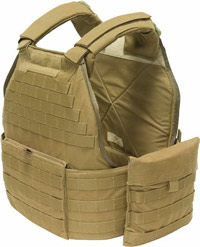
Body armor and ballistic rated panels (for use in packs, briefcases, or other off-body use) are described best by the well-known Kafkaesque adage: It is better to have it and not need it, than to need it and not have it. I don’t mock the “tacticool” nature of body armor, and I avoid debating the SWAT or military “wannabe” aspects of owning it. (I readily acknowledge you are not alone if you do). I think armored materials are something worthy of consideration for anyone who frequents gunfighting classes, shoots regularly, or because of employment or other lifestyle particulars, has concerns of going where negligent friendlies or armed hostiles might be present. The days of body armor being only for LEOs passed (somewhat quietly) years ago.
Executive Summary: Let’s default to my deadly force paradigm: If you CAN afford it, and CAN do what you need to do when it is deployed (adequately conceal it, run and move effectively, maybe in confined space, and shoot, with additional bulky kit, maybe 18 pounds worth), go for it. If you acquire it, study up on and observe the manufacturer’s storage and care specs for the particular product. Unless a specific federal, state, or local law prohibits the ownership of such products, the non-sworn MAY own/wear body armor and ballistic-rated materials. SHOULD you buy such products? That is for you the reader to answer, as is how/when to use it. If you buy, buy the best-tested you can afford which is convenient to deploy, fits properly, and can be stored and maintained to suit your lifestyle. Expect some ribbing from “friends.” How about the MUST? It is beyond question the products save lives. Yours and/or the life of someone you “cannot live without,” regardless of who is slinging shots. At the very least, overt soft armor and plate carriers provide convenient, user-friendly platforms to attach identifying patches, pouches, and other “things.” And plates do provide a good weight-bearing workout. Continue reading →

















